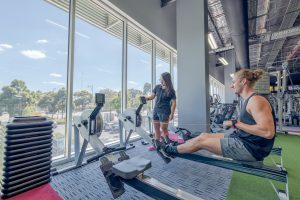Foam rolling is a self-myofascial release (SMR) technique that has been embraced throughout the fitness industry. This effective and simple to do technique delivers positive, feel good results.
Foam rollers have become easily accessible, either shared at the gym or found in almost any sporting goods aisle to bring home for a minimal investment. This makes it one of the “go-to” pieces of equipment for fitness professionals.
Using the foam roller can deliver improvements in flexibility, muscle recovery, movement efficiency, inhibiting overactive muscles, and pain reduction with just minutes of application!
Why Use Myofascial Release?
SMR can be done with a variety of tools beyond foam rollers, such as medicine balls, handheld rollers or other assistive devices.
Whatever the tool selected, SMR focuses on the neural and fascial systems in the body that can be negatively influenced by poor posture, repetitive motions, or dysfunctional movements.
These mechanically stressful actions are recognised as an injury by the body, initiating a repair process called the Cumulative Injury Cycle. This cycle follows a path of inflammation, muscle spasm, and the development of soft tissue adhesions that can lead to altered neuromuscular control and muscle imbalance.
The adhesions reduce the elasticity of the soft tissues and can eventually cause a permanent change in the soft tissue structure, referred to as Davis’s Law. SMR focuses on alleviating these adhesions (also known as “trigger points” or “knots”) to restore optimal muscle motion and function.
SMR is based on the principal of autogenic inhibition. Skeletal muscle tissue contains muscle spindles and Golgi tendon organs (GTO), two neural receptors. Muscle spindles are sensory receptors running parallel to muscle fibres, sensitive to a change and rate of muscle lengthening. When stimulated, they will cause a myotatic stretch reflex that causes the muscle to contract.
The GTO receptors, located in the musculotendinous junctions are stimulated by a change and rate of tension and when they are stimulated will cause the muscle to relax.
When a change in tension is sustained at an adequate intensity and duration, muscle spindle activity is inhibited causing a decrease in trigger point activity, accompanied by a reduction of pain.
In simpler terms, when the pressure of the body against the foam roller is sustained on the trigger point, the GTO will “turn off” the muscle spindle activity allowing the muscle fibres to stretch, unknot, and realign.
The Benefits Of Myofascial Release
SMR benefits include:
Correction of muscle imbalance
- Muscle relaxation
- Improved joint range of motion
- Improved neuromuscular efficiency
- Reduced soreness and improved tissue recovery
- Suppression/reduction of trigger point sensitivity and pain
- Provide optimal length-tension relationships
- Decrease the overall effects of stress on the human movement system




